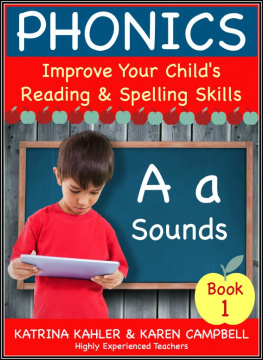Pamela Brookes - How to Use Decodable Books to Teach Reading
Here you can read online Pamela Brookes - How to Use Decodable Books to Teach Reading full text of the book (entire story) in english for free. Download pdf and epub, get meaning, cover and reviews about this ebook. year: 2019, publisher: DOG ON A LOG Books, genre: Children. Description of the work, (preface) as well as reviews are available. Best literature library LitArk.com created for fans of good reading and offers a wide selection of genres:
Romance novel
Science fiction
Adventure
Detective
Science
History
Home and family
Prose
Art
Politics
Computer
Non-fiction
Religion
Business
Children
Humor
Choose a favorite category and find really read worthwhile books. Enjoy immersion in the world of imagination, feel the emotions of the characters or learn something new for yourself, make an fascinating discovery.
- Book:How to Use Decodable Books to Teach Reading
- Author:
- Publisher:DOG ON A LOG Books
- Genre:
- Year:2019
- Rating:5 / 5
- Favourites:Add to favourites
- Your mark:
How to Use Decodable Books to Teach Reading: summary, description and annotation
We offer to read an annotation, description, summary or preface (depends on what the author of the book "How to Use Decodable Books to Teach Reading" wrote himself). If you haven't found the necessary information about the book — write in the comments, we will try to find it.
Sixty-five percent of U.S. fourth graders are not proficient readers because their teachers have not been taught how to teach reading using evidence-based methods. Up to 20% of children have dyslexia. Few receive the individualized teaching they need from their schools.
To help parents and teachers who want to teach their children using an evidence-based, effective method, Pamela Brookes, the mother of a child with dyslexia, discusses their daily routine as she teaches her daughter to read using the decodable DOG ON A LOG Books series. As the author of DOG ON A LOG Books, Pamela also shares how to choose where in the series to start. She shares how she teaches each of the phonics rules used in the book series along with the reasons for teaching the syllable types and handwriting. Although this booklet is meant to guide parents and teachers using DOG ON A LOG Books, the information can be adapted and applied to any systematic series of decodable books.
How to Use DOG ON A LOG Books to Teach Reading is edited by Dr. Nancy Mather, a professor in learning disabilities, reading, and writing to make sure it follows the scientific research on teaching reading.
This edition includes information on Steps 1 to 10 of the DOG ON A LOG phonics rules. Additional steps will be added as the future decodable chapter books are created.
All DOG ON A LOG Books follow a structured literacy/Orton-Gillingham based phonics sequence. You can download printable gameboards, flashcards, and other literacy materials at www (dot) dogonalogbooks (dog) com.
Pamela Brookes: author's other books
Who wrote How to Use Decodable Books to Teach Reading? Find out the surname, the name of the author of the book and a list of all author's works by series.



















